Overcoming Bar Management Challenges: Tips for Running a Successful Bar

Running bars is more than simply mixing cocktails and entertaining guests; it’s a balancing act of managing staff, keeping costs in check, and ensuring customer satisfaction. It’s no surprise that nearly 60% of new bars close within their first three years, highlighting the challenges inherent in the restaurant industry. But those who succeed do so by understanding these challenges and mastering the bar management process to become a successful bar manager.
Whether you’re grappling with staffing issues or trying to maintain profitability, overcoming these hurdles is key to successfully managing a bar. The good news is that with the right strategies, you can turn these challenges into opportunities for growth and efficiency.
In this article we’ll cover:
- Labor Shortage
- Inventory Management
- Financial Management
- Customer Service
- Compliance and Legal Issues
- Marketing and Promotions
- Supply Chain Disruptions
- Multi-Location Challenges
- Conclusion
- About Supy
Ready to transform your approach to bar management? Let’s explore the essential strategies that will help you navigate the toughest challenges and set your bar on the path to long-term success.
1. Labor Shortage
Labor shortages are a major challenge in the bar industry, with many operating at just 60-85% of needed staff. This leads to overworked employees, declining service quality, and potential damage to the bar’s reputation. The pandemic worsened the issue, pushing many workers to more stable jobs. As a result, bars must hire and train less experienced staff, creating a cycle of understaffing, high turnover, and operational inefficiencies.
Solutions
- Invest in Employee Retention: Create a positive work environment with competitive pay, benefits, and opportunities for advancement. Implementing employee incentive programs, such as bonuses or rewards for exceptional performance, can further boost morale and loyalty. An outstanding company culture can enhance employee satisfaction, making your bar a more attractive place to work and helping retain valuable employees.
- Flexible Hiring and Training Employees: Hire individuals with less experience and offer comprehensive training programs to ensure they meet your bar’s standards. A thorough approach to training staff can quickly turn new hires into efficient team members, reducing the burden on your more experienced employees.
- Optimize Scheduling and Workload: Use data-driven scheduling to evenly distribute work and prevent burnout. Flexible schedules allow bar staff to balance work with personal life, improving job satisfaction and performance, which ultimately benefits the restaurant manager and overall bar operations.
2. Inventory Management
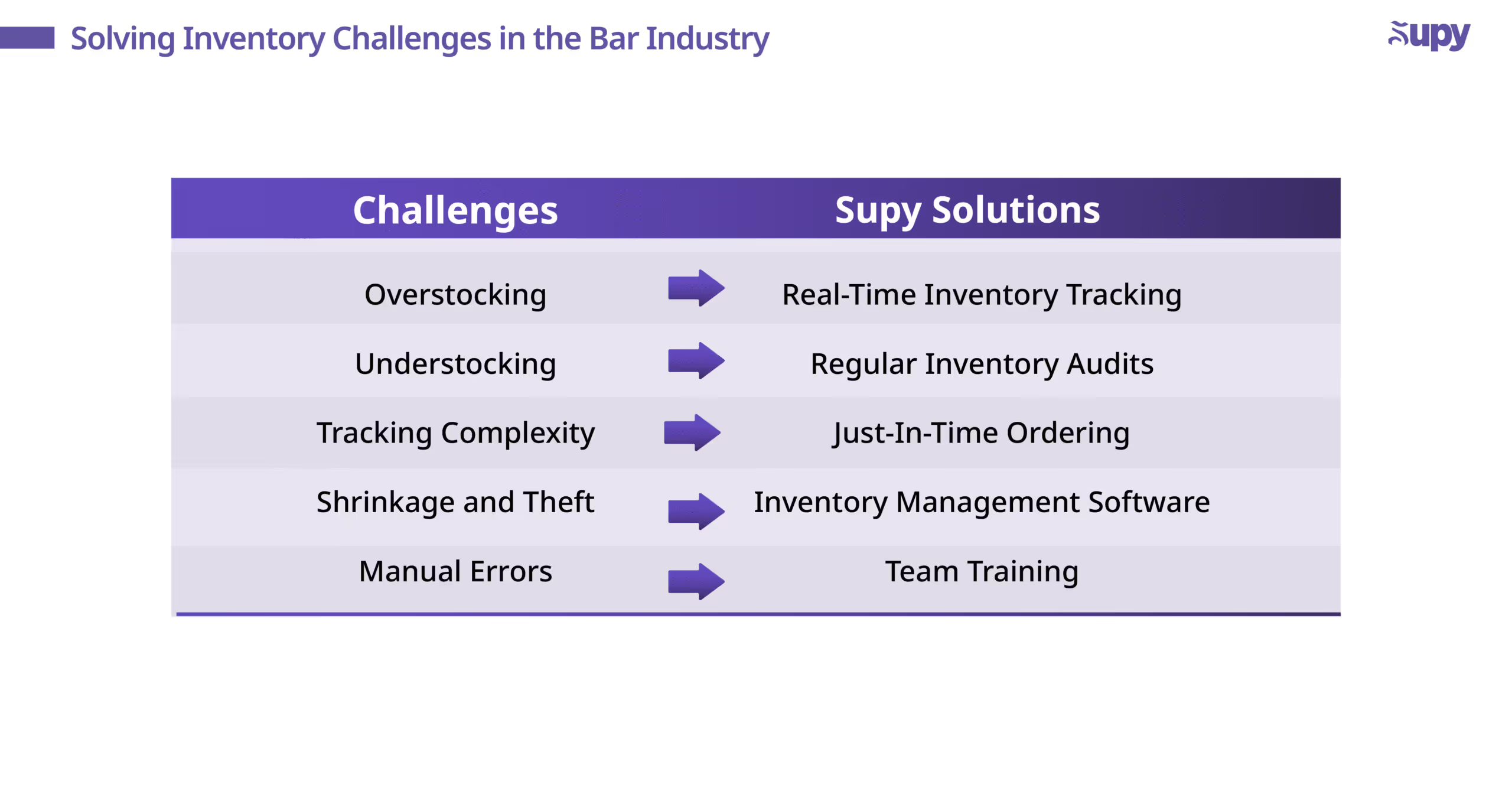
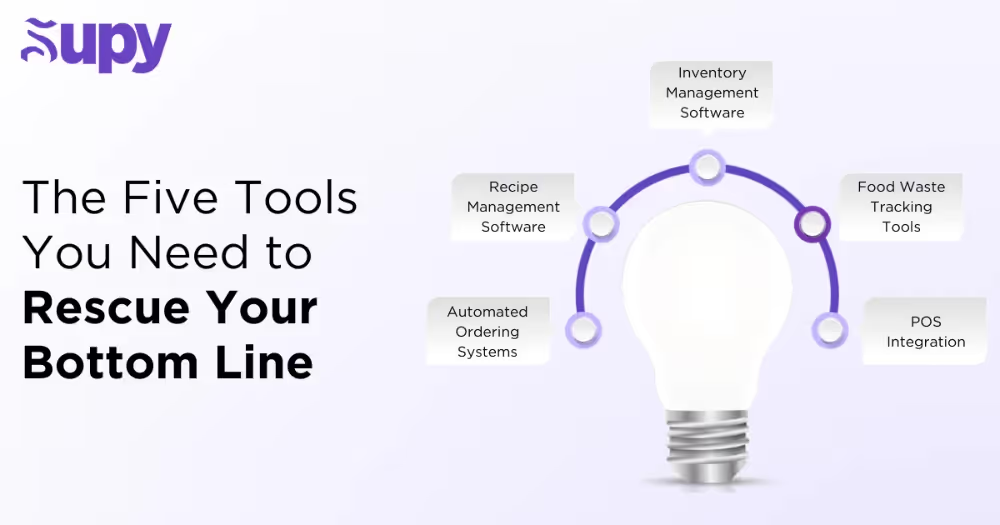
Managing bar inventory is challenging but essential for success. Poor inventory control can lead to overstocking, tying up capital and increasing waste, or understocking, resulting in lost sales and disappointed customers. Bar managers constantly struggle to balance stock levels, especially with the complexity of tracking multiple items in fast-paced environments. Theft and shrinkage add another layer of risk, making accurate tracking crucial. A robust inventory system or bar management software helps streamline operations, reduce waste, and provide real-time insights to protect profits.
Solutions
- Implement Real-Time Inventory Tracking: Use inventory management software like Supy to monitor stock levels in real time. This technology allows you to keep an eye on your inventory as it fluctuates throughout the day, ensuring that you always know what’s on hand. By tracking inventory in real time, you can reduce waste, prevent overstocking, and avoid running out of popular items during peak hours.
- Conduct Regular Inventory Audits: Schedule routine inventory checks to catch discrepancies early. Regular audits help you spot trends, such as items that are frequently over-ordered or underused, allowing you to make adjustments before they impact your bottom line. Consistent inventory audits also help in identifying potential theft or loss, ensuring your stock levels match your sales records.
- Implement Just-In-Time Ordering: Utilize a just-in-time ordering system to minimize the amount of stock held on-site. By ordering supplies closer to when they are needed, you can reduce excess inventory and free up capital. This approach also helps in maintaining fresher stock, which can improve the quality of the products you serve and reduce waste. A well-managed liquor inventory system is key to achieving this balance.
3. Financial Management
Managing bar finances goes beyond counting cash; it requires strategic planning and analysis to maintain profitability. With tight margins in the hospitality industry, even small financial missteps can lead to cash flow issues and rising costs. Controlling expenses without sacrificing quality is a key challenge, as every cost, from inventory to labor, affects the bottom line. Regularly reviewing profit and loss statements helps bar managers track spending, identify savings opportunities, and ensure long-term financial stability.
Solutions
- Leverage Financial Analytics Tools: Implementing financial management software helps bars monitor key metrics like inventory turnover and labor costs, enabling data-driven decisions that boost profitability. Tools like Toast and Lightspeed track sales trends and staff performance, while inventory management solutions like Supy prevent overstocking, reduce waste, and detect variance due to theft or over-pouring. For broader financial oversight, QuickBooks and Xero provide real-time expense tracking and profit analysis. By leveraging these tools, bars can streamline financial operations and optimize costs for better long-term profitability.
- Stick to a Detailed Budget: Create a comprehensive budget that covers all operating expenses and regularly compare it against actual spending. This practice helps you keep spending in check, identify variances early, and make adjustments as needed to maintain financial stability, ensuring your bar remains on a profitable path.
- Optimize Menu Pricing: Analyze the profitability of each menu item using data from your financial reports. Consider implementing dynamic pricing, where prices are adjusted based on demand or time of day, to maximize revenue. Adjust prices or portion sizes to highlight high-margin items, ensuring your menu is both profitable and appealing to customers, contributing to a more successful bar management strategy.
4. Customer Service
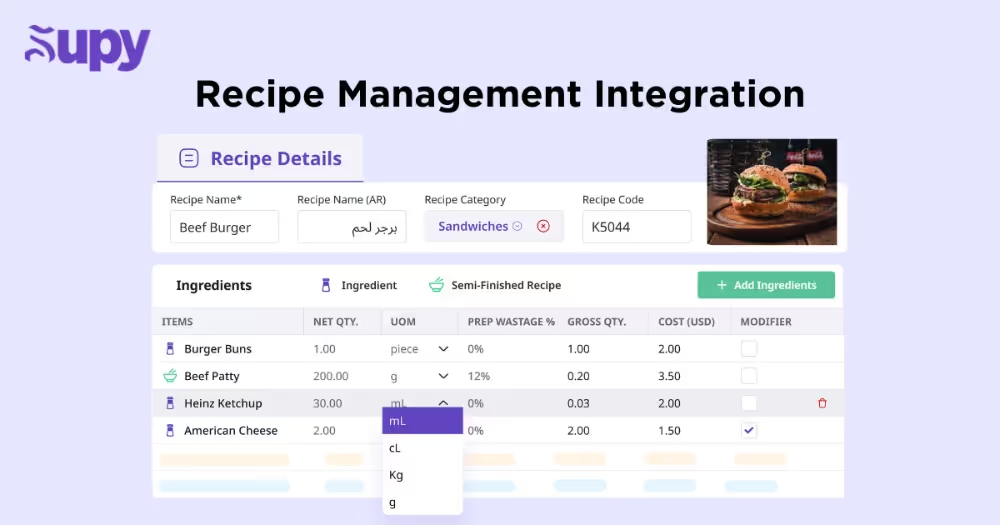
Customer service is the backbone of a successful bar, influencing whether customers return or recommend your establishment. In a competitive industry, exceptional service fosters loyalty and repeat business. However, high staff turnover, busy periods, and varying customer expectations make consistency challenging. Without strong service management, even well-run bars can struggle to retain customers. Addressing concerns promptly and prioritizing service is key to building long-term loyalty.
Solutions
- Regular Staff Training: Invest in continuous training to ensure your team is skilled in customer interaction and service techniques. Regular refreshers and professional development opportunities help keep the staff aligned with your service standards, enabling them to deliver a consistently excellent experience.
- Personalize the Customer Experience: Encourage staff to remember regular customers' preferences and engage with them on a personal level. Small gestures, like recalling a customer’s favorite drink, can make them feel valued and enhance their loyalty to your bar, which can also positively influence online reviews.
- Gather and Act on Feedback: Regularly collect customer feedback through surveys or direct conversations to address any customer concerns. Use this feedback to identify areas for improvement and make changes that align with customer expectations, ensuring your bar meets their needs and continues to thrive in a competitive environment.
5. Compliance and Legal Issues
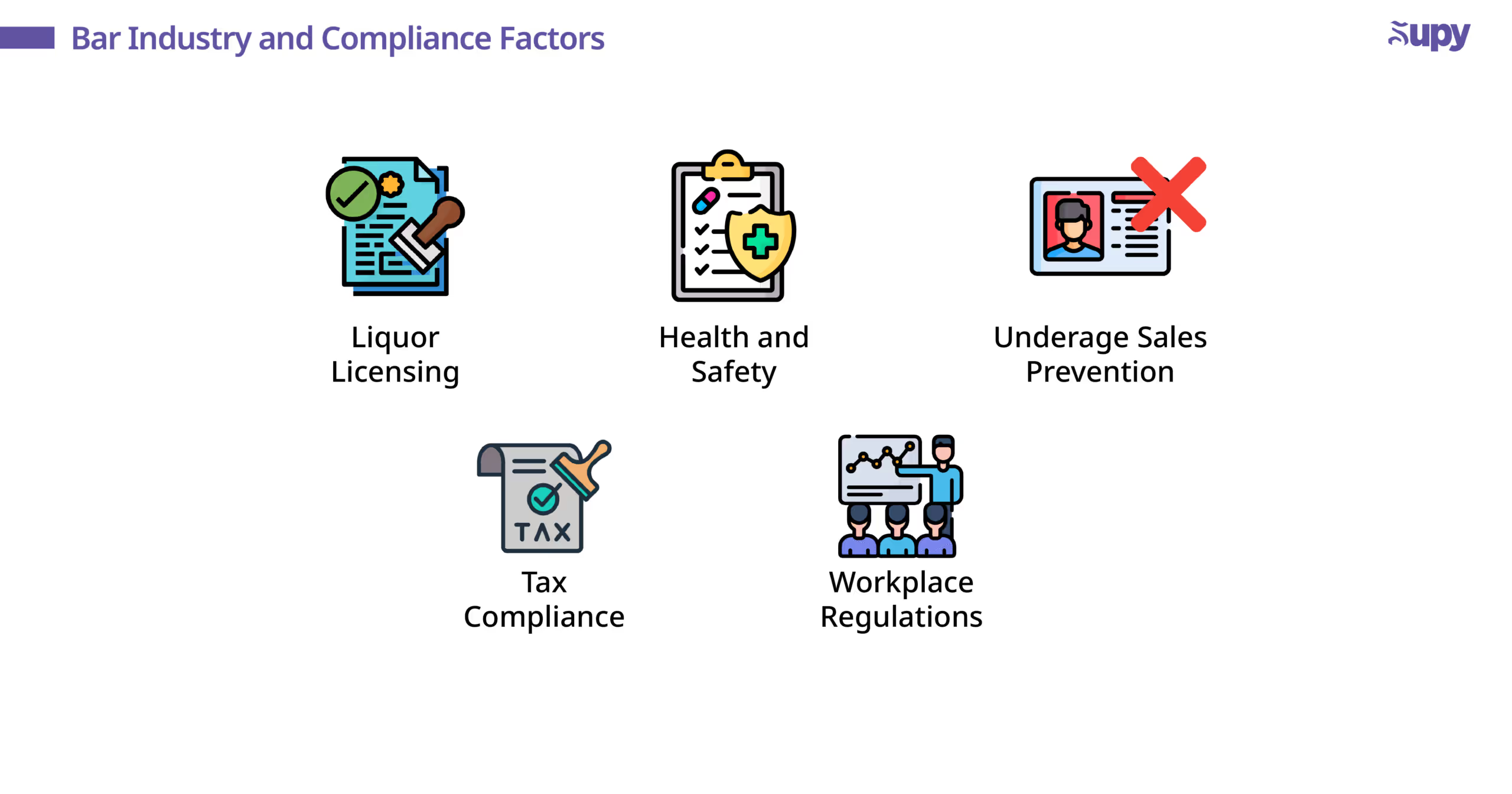
Managing legal compliance is essential for any bar. From liquor licensing to health and safety standards, failure to meet regulations can result in fines, legal action, or even closure. The challenge is that laws vary by location and frequently change, requiring constant attention. Keeping staff informed and compliant adds to the workload, but it's crucial for protecting your bar’s reputation and long-term success.
Solutions
- Stay Informed and Updated: Regularly review local, state, and federal regulations that apply to your bar. Subscribe to industry newsletters or legal updates to stay informed about any changes in laws or consumer trends that might affect your operations. Staying proactive in this regard helps ensure your bar remains compliant at all times.
- Conduct Regular Compliance Audits: Perform routine checks to ensure that your bar is adhering to all legal requirements, from liquor licensing to health and safety standards. These audits can help you identify potential issues before they become serious problems, reducing the risk of fines or legal action and contributing to your bar’s success.
- Train Staff on Legal Requirements: Ensure that all employees are aware of the legal obligations related to their roles, particularly around alcohol service and customer safety. Regular training sessions keep your team informed and compliant, minimizing the risk of violations that could jeopardize your business and helping you manage a bar more effectively.
6. Marketing and Promotions
In the competitive bar industry, strong marketing is key to attracting and retaining customers. A unique brand identity and consistent engagement help set your bar apart. However, limited budgets, lack of expertise, and fast-changing trends make marketing a challenge. Staying relevant requires creativity and a proactive approach, using social media, events, and loyalty programs to drive traffic and boost sales.
Solutions
- Leverage Social Media: Use platforms like Instagram, Facebook, and Twitter to engage with your audience and promote events, specials, and new menu items. Regularly posting high-quality images, videos, and stories can keep your bar top of mind for potential customers and help build a loyal online following.
- Host Unique Events and Promotions: Organize themed nights, live music, or tasting events that appeal to your target demographic. These events not only attract new customers but also give regular patrons a reason to visit more frequently, increasing their overall spending at your bar.
- Implement a Loyalty Program: Create a rewards program that incentivizes repeat visits by offering discounts, free drinks, or exclusive perks to loyal customers. A well-designed loyalty program can boost customer retention and encourage word-of-mouth referrals, helping your bar grow organically.
7. Supply Chain Disruptions
Supply chain disruptions have made it harder for bars to secure key ingredients and equipment, leading to shortages, higher costs, and menu changes that frustrate customers. Without a proactive plan, these issues can impact service quality and profitability. Bars must build strong supplier relationships, stay flexible, and use smart inventory management to navigate unpredictability.
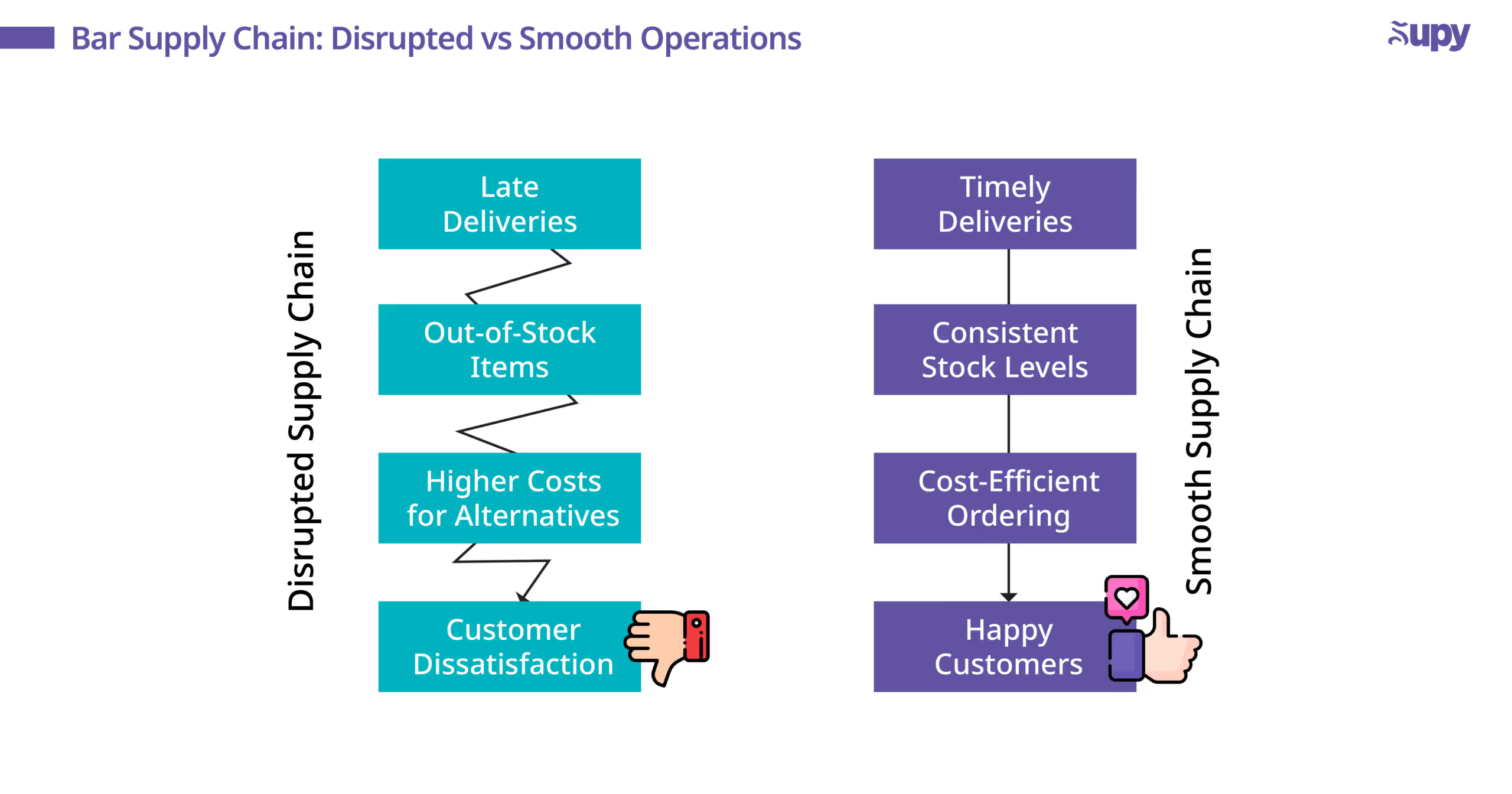
Solutions
- Diversify Your Supplier Network: Work with multiple suppliers for your key products to reduce dependency on any single source. By diversifying your supplier network, you can better manage risks and ensure that disruptions with one supplier won’t leave you without essential items.
- Use Smart Procurement Tools: Implement procurement software, like Supy, to track your stock levels and forecast future needs. These tools can help you anticipate shortages and adjust your orders accordingly, ensuring that your bar remains well-stocked even during supply chain disruptions.
- Build Strong Relationships with Suppliers: Develop and maintain good relationships with your suppliers to ensure better communication and flexibility in times of disruption. Strong relationships can lead to more favorable terms, priority service, and quicker resolution of issues when they arise, helping your bar navigate supply chain challenges more effectively.
8. Multi-Location Challenges
Managing multiple bar locations brings challenges in maintaining consistency, efficiency, and quality. Different customer bases, staff dynamics, and regulations make a uniform strategy difficult. Ensuring a consistent brand experience across locations is crucial, as variations in service or offerings can weaken reputation. Remote staff management adds complexity, requiring strong training and oversight to maintain standards.
Solutions
- Standardize Operations Across Locations: Develop and implement standardized procedures for inventory management, staff training, and customer service. This ensures consistency across all locations, helping to maintain a uniform brand experience for customers, regardless of which bar they visit.
- Use Centralized Management Software: Implement centralized management software that allows you to monitor and manage all locations from a single platform. Tools like Supy can help streamline inventory management, ordering processes, and data analysis, ensuring that each location operates efficiently while adhering to the same standards.
- Conduct Regular Cross-Location Audits: Perform regular audits across all locations to ensure compliance with company standards and identify areas for improvement. These audits should assess everything from inventory levels to customer service quality, helping you maintain consistency and address any issues before they affect your business on a larger scale.
9. Conclusion
Successfully managing a bar requires more than just a passion for hospitality; it demands a strategic approach to overcoming the various challenges that can impact your operations. By applying the right bar management tips, such as addressing labor shortages, optimizing inventory management, and leveraging financial oversight, you can turn potential obstacles into opportunities for growth. Utilizing automated systems, like inventory management software, can streamline processes and enhance your management experience.
Whether you’re a bar owner running a single location or managing multiple bars, focusing on consistency, efficiency, and customer satisfaction will set your business on a path to long-term success. With the insights and tools provided in this guide, you’re well-equipped to tackle these challenges head-on and ensure your bar thrives in a competitive industry.
10. About Supy
Supy is an all-in-one solution designed specifically for the unique challenges of the hospitality industry, including bars and restaurants. From real-time inventory tracking and smart procurement to centralized management for multiple locations, Supy streamlines operations and helps you maintain consistency across all aspects of your business.
By leveraging advanced analytics and automation, Supy enables bar managers to optimize everything from inventory levels to financial management, ultimately driving profitability and enhancing customer satisfaction. Ready to see how Supy can transform your bar management? Book a demo today and discover the difference Supy can make for your business.







